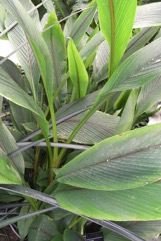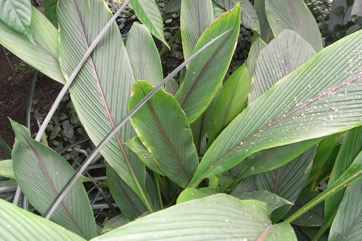Zedoary, Zeodary

It is a tropical plant. It grows in hot humid climates. It suits areas with a rainfall of 90-125 cm per year. It grows up to 900 m altitude. It grows in shady places often under betel nut groves. It needs a loamy well cultivated soil. It needs a temperature above 13°C. It suits hardiness zones 8-12. In Yunnan.
Also known as:
Biring, Kachoor, Kachora, Kachura, Khamin khao, Kochura, Kunchur, Nghe den, Palagunda, Palua, Rose turmeric, Sa-nwin, Shoti, Sying khlo, Tempu puteh, Temu Kuning, Temu pepet, Temu putih, Vundu, Zadwar
Synonyms
- Amomum latifolium Lamk.
- Amomum latifolium Salisb.
- Amomum zeodaria Christmann
- Amomum zerumbet J. Koenig [Illegitimate]
- Costus luteus Blanco
- Costus nigricans Blanco
- Curcuma officinalis Salisb.
- Curcuma pallida Lour.
- Curcuma speciosa Link
- Curcuma zerumbet Roxb.
Edible Portion
- Leaves, Rhizome, Root, Flowers, Spice, Vegetable
Where does Zedoary grow?
Found in: Africa, Asia, Australia, Bangladesh, Cambodia, China, East Africa, Hawaii, Himalayas, India, Indochina, Indonesia, Madagascar, Malaysia, Myanmar, Northeastern India, Pacific, Philippines, SE Asia, Sierra Leone, Sri Lanka, Taiwan, Thailand, United States, Vietnam, West Africa
Notes: There are about 50 Curcuma species. They are mostly in SE Asia.
Status: It is a commercially cultivated vegetable. The starch is easily digested.
Growing Zedoary, Zeodary
Cultivation: Plants are grown using parts of the rhizome. Using the main or mother rhizome is best. Germination of the rhizomes is often started in a nursery. They are then planted out at the beginning of the rainy season. They are mostly planted on flat beds which are later mounded. A spacing of 25-45 cm is suitable.
Edible Uses: The rhizomes are used as a condiment but not popular. They are peeled and finely shredded. The starch is extracted and used. The young tender buds are eaten in salads. The leaves are also eaten cooked with fish.
Production: It takes 1,100 kg of rhizomes to plant one hectare. It takes 10 months to produce a crop. Yields of 7.5-12 tonnes per hectare occur.
Nutrition Info
per 100g edible portion| Edible Part | Energy (kcal) | Protein (g) | Iron (mg) | Vitamin A (ug) | Vitamin c (mg) | Zinc (mg) | % Water |
|---|---|---|---|---|---|---|---|
| Roots | 36 | 1 | 0.8 | 210 | 15 | 0.1 | 90 |
Zedoary, Zeodary Photos


References
Ambasta, S.P. (Ed.), 2000, The Useful Plants of India. CSIR India. p 152
Anderson, E. F., 1993, Plants and people of the Golden Triangle. Dioscorides Press. p 208
Arora, R. K., 2014, Diversity in Underutilized Plant Species - An Asia-Pacific Perspective. Bioversity International. p 102
Bremness, L., 1994, Herbs. Collins Eyewitness Handbooks. Harper Collins. p 163
Brown, D., 2002, The Royal Horticultural Society encyclopedia of Herbs and their uses. DK Books. p 187
Burkill, H. M., 1985, The useful plants of west tropical Africa, Vol. 5. Kew.
Burkill, I.H., 1966, A Dictionary of the Economic Products of the Malay Peninsula. Ministry of Agriculture and Cooperatives, Kuala Lumpur, Malaysia. Vol 1 (A-H) p 724
Chen, I., et al, 2008, Antioxidant and Antimicrobial Activities of Zingiberaceae Plants in Taiwan. Plant Foods for Human Nutritition, 63:15-20
Deb, D., et al, 2013, Wild Edible Plants and Their Utilization in Traditional Recipes of Tripura, Northeast India. Advances in Biological Research 7(5):203-211
Facciola, S., 1998, Cornucopia 2: a Source Book of Edible Plants. Kampong Publications, p 248
Hani Medicine of Xishuangbanna, 1999, p 51
Hedrick, U.P., 1919, (Ed.), Sturtevant's edible plants of the world. p 254
Hemphill, I, 2002, Spice Notes. Macmillan. p 418
Heywood, V.H., Brummitt, R.K., Culham, A., and Seberg, O., 2007, Flowering Plant Families of the World. Royal Botanical Gardens, Kew. p 409
Hibbert, M., 2002, The Aussie Plant Finder 2002, Florilegium. p 78
http://www.ntbg.org/plants/plant details.php
Hu, Shiu-ying, 2005, Food Plants of China. The Chinese University Press. p 328
Jiwajinda, S., et al, 2002, Suppressive Effects of Edible Thai Plants on Superoxide and Nitric Oxide Generation. Asian Pacific Journal of Cancer Prevention, Vol 3, 2002
Kay, D.E., 1973, Root Crops, Digest 2, Tropical Products Institute, London, p 135
Kays, S. J., and Dias, J. C. S., 1995, Common Names of Commercially Cultivated Vegetables of the World in 15 languages. Economic Botany, Vol. 49, No. 2, pp. 115-152
Lembaga Biologi Nasional, 1977, Ubi-Ubian, Balai Pustaka, Jakarta. p 88
Lim, T. K., 2015, Edible Medicinal and Non Medicinal Plants. Volume 9, Modified Stems, Roots, Bulbs. Springer p 30
Llamas, K.A., 2003, Tropical Flowering Plants. Timber Press. p 367
Martin, F.W. & Ruberte, R.M., 1979, Edible Leaves of the Tropics. Antillian College Press, Mayaguez, Puerto Rico. p 225
Misra, R. C., et al, 2013, Genetic resources of wild tuberous food plants traditionally used in Similipal Biosphere Reserve, Odisha, India. Genetic Resources and Crop Evolution. Vol. 60 No. 2. Springer
Ochse, J. J. et al, 1931, Vegetables of the Dutch East Indies. Asher reprint. p 745
Patiri, B. & Borah, A., 2007, Wild Edible Plants of Assam. Geethaki Publishers. p 142
Phawa, G. M., Dkhar, E. K. & Marbaniang, D., 2019, Indigenous Wild Edible Plants of Bataw Village, East Jaintia Hills District, Meghalaya. International Journal of Arts, Science and Humanities. 7(2)
Phon, P., 2000, Plants used in Cambodia. © Pauline Dy Phon, Phnom Penh, Cambodia. p 185
PROSEA handbook Volume 13 Spices. p 276
Purseglove, J.W., 1972, Tropical Crops. Monocotyledons. Longmans p 522
Recher, P, 2001, Fruit Spirit Botanical Gardens Plant Index. www.nrg.com.au/~recher/ seedlist.html p 4
Seidemann J., 2005, World Spice Plants. Economic Usage, Botany, Taxonomy. Springer. p 127
Singh, H.B., Arora R.K.,1978, Wild edible Plants of India. Indian Council of Agricultural Research, New Delhi. p12
Sirirugsa, P., 1999, Thai Zingiberaceae: Species Diversity and their Uses. http://www.iupac.org/symposia/proceedings/phuket 97
Solomon, C., 2001, Encyclopedia of Asian Food. New Holland. p 418
Staples, G.W. and Herbst, D.R., 2005, A tropical Garden Flora. Bishop Museum Press, Honolulu, Hawaii. p 763
Sukarya, D. G., (Ed.) 2013, 3,500 Plant Species of the Botanic Gardens of Indonesia. LIPI p 1098
Terra, G.J.A., 1973, Tropical Vegetables. Communication 54e Royal Tropical Institute, Amsterdam, p 43
Trans. Linn. Soc. London 8:354. 1807
Tutul, E et al, 2009, Angiospermic Flora of Runctia Sal Forest, Bangladesh. Bangladesh J. Plant Taxon. 16(1): 83-90. p 86
Van Sam, H. et al, 2008, Uses and Conservation of Plant Species in a National Park. A case study of Ben En, Vietnam. Economic Botany 62:574-593
van Wyk, B., 2005, Food Plants of the World. An illustrated guide. Timber press. p 165
World Checklist of Useful Plant Species 2020. Royal Botanic Gardens, Kew